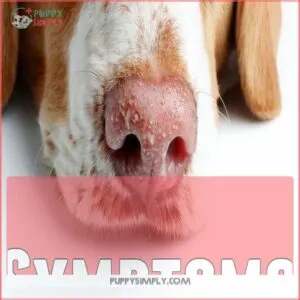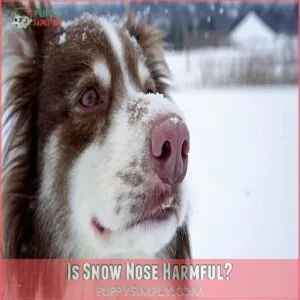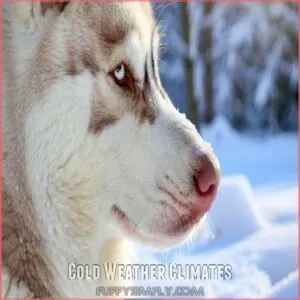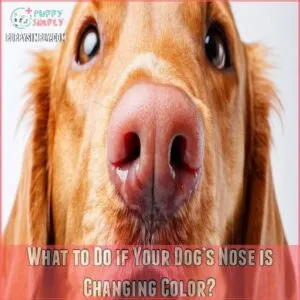This site is supported by our readers. We may earn a commission, at no cost to you, if you purchase through links.

These rosy schnozzles aren’t just for show – they’re often the result of genetics or a condition called "snow nose," where the nose color changes with the seasons.
While these pink-nosed pups are perfectly healthy, they’ll need extra TLC since their noses are more sensitive to sunlight.
From the speckled butterfly nose of a Bull Terrier to the seasonal pink tinge of a Husky’s nose, these unique features add character to your furry friend.
There’s more to keeping these sensitive sniffers healthy than meets the eye.
Table Of Contents
- Key Takeaways
- Breeds With Pink Noses
- What is Dog Snow Nose?
- Is Snow Nose Harmful?
- How to Prevent Snow Nose?
- Can Snow Nose Be Treated?
- What to Do if Your Dog’s Nose is Changing Color?
- Why Does Snow Nose Affect Certain Breeds?
- How to Care for a Dog With Snow Nose?
- Can Snow Nose Be Linked to Skin Cancer?
- Frequently Asked Questions (FAQs)
- Do dogs have pink noses?
- What dog breeds have pink noses?
- Is a pink nose a good breed for a purebred dog?
- Why does my dog’s nose turn pink?
- What is a pink-nosed dog breed?
- Does a pink nose affect a dog’s personality?
- What does a pink nose mean on a dog?
- What breed of dog has a pink nose?
- What causes a Dudley nose?
- Is a snow nose permanent?
- Conclusion
Key Takeaways
- You’ll find pink noses in popular breeds like Labrador Retrievers, Bull Terriers, and Dalmatians, often due to genetics or a condition called "snow nose" where the nose color changes seasonally.
- While pink-nosed dogs are perfectly healthy, you’ll need to protect their sensitive noses with dog-safe sunscreen and moisturizing balms to prevent sunburn and dryness.
- If you notice your dog’s nose turning pink during winter months, don’t worry – it’s likely "snow nose," a harmless condition caused by temperature-related changes in pigment production that typically reverses in warmer weather.
- Your dog’s pink nose won’t affect their personality, breed status, or sense of smell, but you should monitor any sudden color changes and consult a vet if you notice unusual textures or discharge.
Breeds With Pink Noses
Some dog breeds naturally have pink noses, adding to their unique charm and individuality. You’ll find this trait in breeds like Labrador Retrievers, Boxers, and Dalmatians, among others.
Labrador Retriever
Labrador Retrievers, those lovable goofballs, can develop a pink nose due to their Dudley Nose genetics. This unique trait affects pigmentation, giving their noses a lighter, sometimes pinkish hue.
Snow Nose or Butterfly Nose patterns might also appear.
If your Lab has a pink nose, don’t forget sunscreen—sun protection is important to keep their sensitive snouts safe and healthy!
Australian Shepherd
Considering an Australian Shepherd? They often have a pink nose. They can be prone to snow nose, like Dudley Nose, affecting Australian Shepherd puppies.
Key characteristics include:
- Merle coat
- Herding instincts
- Aussie health
- Pink nose
Irish Setter
Irish Setters steal hearts with their fiery red coats, but their noses can be just as unique. Thanks to liver gene inheritance, some Irish Setters sport a charming reddish-pink nose, giving them even more personality. This recessive gene causes the lighter pigmentation, and in certain cases, you might even notice the nose color shift over time—from black to brown or pink.
Here’s a quick breakdown:
| Trait | Detail |
|---|---|
| Nose Color | Reddish-pink due to liver gene inheritance. |
| Health Impact | No issues; the nasal texture remains normal. |
Setter nose health is typically trouble-free, but keep an eye out in colder months. Snow Nose, though rare in this breed, can fade parts of their nose pigmentation. Whether lounging indoors or exploring outdoors, Irish Setters with pink noses need extra care against sun sensitivity. A dab of dog-safe sunscreen might just keep that precious nose in top shape!
Bull Terrier
Bull Terriers are a standout among pink nose dog breeds, known for their quirky looks and friendly temperament. Their "butterfly nose" features pink tones with black freckles—a nose that’s as unique as their personality.
These playful dogs are great companions but come with a few health concerns, like skin allergies and joint issues.
To keep them thriving, focus on these essentials:
- Grooming needs are simple—just regular brushing to maintain their sleek coat.
- Training tips include using positive reinforcement since they’re keen to please.
- Stay vigilant about their overall health, especially skin care for their patterned noses.
Dogo Argentino
The Dogo Argentino, a powerhouse of loyalty and charm, often features flecked nose patterns with hints of pink. These subtle pink marks are part of its breed standard noses, stemming from genetic traits.
These dogs with pink noses need extra care due to sun sensitivity.
Regular sunscreen and moisturizing guarantee proper Argentino nose care, maintaining both their health and striking appearance.
Boxer
Boxer puppies often charm you with their bright pink noses, a unique trait tied to White Boxer genetics.
While most adult Boxers develop black noses, small pink spots can linger. Pink nose care is essential since these dogs with pink noses need sun protection to avoid burns.
A Boxer’s nose health aligns with their breed’s standard and requires regular attention.
Dalmatian
If you thought Boxers had unique looks, wait until you meet a Dalmatian. Famous for their striking black-and-white spots, Dalmatians sometimes also sport pink noses, adding an extra touch of charm. This pink nose coloration often comes from a recessive liver gene, and while it’s eye-catching, it doesn’t affect their health at all.
Dalmatians are more than just their looks. They’re smart, energetic, and incredibly loyal, though they can have a stubborn streak. Training early (and sticking with it) will help you shape this charismatic breed into a well-behaved companion.
Here’s a quick guide to what makes Dalmatians stand out:
- Dalmatian nose color: Ranges from black to pink, depending on genetics.
- Sun sensitivity: Dogs with lighter noses may need sunscreen to avoid burns.
- Health concerns: Pink nose dogs can still enjoy excellent health.
- Common myths: Pink noses don’t mean the breed is unhealthy!
Golden Retriever
Golden Retrievers often develop lighter or pink noses due to snow nose—a seasonal pigment change tied to colder weather.
While harmless, it’s good to watch for cracks or dryness. Use sunscreen in sunny months to protect their sensitive snouts.
This lovable pink-nose dog breed adds charm with its unique feature, reminding you why Golden Retriever care needs your attention year-round.
White Boxer
White Boxers stand out with their snowy coats and bright pink noses, thanks to genetic influences.
This pink nose dog breed carries unique breed-specific traits, including sun sensitivity care needs.
Pink boxer noses are more delicate, so using dog-safe sunscreen is key.
Regular check-ups prevent health implications, keeping your boxer puppy’s pink nose healthy and happy for snuggles and zoomies!
Siberian Husky
Siberian Huskies sometimes develop pink noses, known as Snow Nose, where their dark noses lighten in winter.
This change is harmless and tied to Husky genetics and pigmentation.
While they thrive in cold climates, keep an eye on canine nose health.
Mild nose discoloration usually isn’t serious, but regular checks, exercise, good nutrition, and pink nose care help maintain overall health.
Beagle
Beagles are lovable family dogs, and thanks to their quirky dog genetics, some sport a pink nose due to a recessive gene.
This eye-catching feature doesn’t impact Beagle health but makes them stand out.
Dogs with nose discoloration like this may need pink nose care, including sunscreen to prevent sunburn.
Regular checkups keep dog nose health in check!
Nova Scotia Duck Tolling Retriever
The Nova Scotia Duck Tolling Retriever, a playful and loyal companion, often sports a pink nose thanks to Nova Scotia genetics.
These pink-nosed puppies may experience pigmentation changes in colder weather. To prevent dog nose problems, focus on pink nose care like sunscreen and moisturizing balms.
Tolling Retriever health thrives with regular check-ups, proper training, and lots of love.
Harlequin Great Dane
You’ll love how unique Harlequin Great Danes are, especially as pink nose dogs! Their genetic traits often lead to striking color variations, from iconic black-and-white coat patterns to solid pink noses.
Here’s what to know:
- Their pink noses stem from hypopigmentation.
- Gorgeous coat patterns reflect their fascinating breed history.
- Sunburn risks demand extra dog nose care tips.
- Monitor for potential dog nose problems.
White German Shepherd
White German Shepherds are stunning with their snowy coat color and unique pink noses, a result of specific genetic traits.
This pink nose dog breed is often admired for its beauty and loyal nature.
While their white markings create a striking appearance, protecting their sensitive noses with sunscreen is essential for Shepherd health.
These pink-nosed puppies meet breed standards effortlessly.
Poodle
Poodles bring sophistication and charm, whether toy, miniature, or standard size. These hypoallergenic dogs sometimes sport pink noses, often paired with liver-colored spots.
Curious about these pups? Here’s why Poodles with pink noses stand out:
- Friendly Temperament
- Intelligent and Keen to Please
- Stunning Coat Colors
- Adaptable for Any Home
- Needs Regular Grooming
Bernese Mountain Dog
The Bernese Mountain Dog is a big-hearted giant with a pink nose, often stemming from genetics.
These cold-climate champs love mountain hiking and thrive on proper dog nutrition. Their friendly personality pairs perfectly with pink-nosed puppies or adults.
Here’s a quick glance:
| Trait | Details | Why It Matters |
|---|---|---|
| Coat | Thick, tri-colored | Cold climate protection |
| Weight | 80-115 pounds | Healthy Bernese structure |
| Activity | Enjoys hiking | Perfect mountain companion |
Samoyed
Samoyeds, those fluffy beauties, often sport pink noses thanks to their unique genetics. Their Dudley Nose, occasionally dotted with liver spots, requires extra sun protection to prevent burns.
Known for their friendly temperament and hypoallergenic fur, these dogs aren’t just pretty faces. Originating as hardworking hunting companions in Siberia, Samoyeds are resilient yet need proper care to guarantee best canine skin health.
Grooming that luxurious coat is a labor of love, but worth it.
English Springer Spaniel
An English Springer Spaniel’s nose can be pink or liver-colored, thanks to its unique genetics. This lively, loyal breed is a favorite, but their nose color requires some attention. Pink noses can mean extra sun sensitivity, so sunscreen helps! Like the english cocker spaniel, they benefit from regular grooming and care.
Keep your Spaniel healthy and happy with these tips:
- Groom often to prevent skin issues that affect nose pigmentation.
- Protect their nose with dog-safe sunscreen during sunny days.
- Feed a balanced diet for overall health and nose care.
- Watch for changes in nose color; consult a vet if needed.
What is Dog Snow Nose?
If you notice your dog’s nose changing from black to pink during winter, you’re likely seeing a condition called snow nose.
This temporary color change happens when cold weather affects the enzyme that produces nose pigment, similar to how some people’s hair gets lighter in winter.
Causes
Ever wondered why your dog’s nose suddenly looks lighter in winter? Let’s explore what causes snow nose in our furry friends.
Understanding dog nose health is essential to recognizing normal variations in nose temperature and color. While genetics play a significant role, several factors can trigger this fascinating color change:
| Factor | Common Cases | Less Common Cases |
|---|---|---|
| Weather | Cold temperatures | Extreme heat |
| Health | Natural aging | Infections, allergies |
| Physical | Minor injuries | Severe trauma |
| Other | Hypopigmentation | Autoimmune conditions |
Your pup’s nose pigmentation might shift due to environmental factors, leading to what’s often called Dudley noses or liver noses.
Think of it like a temporary tattoo that fades – sometimes it’s just nature’s way of adapting to seasonal changes. While snow noses are the most common in winter months, other causes can include simple aging or even benign hormonal fluctuations.
Symptoms
Three telltale signs signal your dog might have Snow Nose. First, you’ll notice their once-dark nose gradually lightening to pink or brown, especially during winter months. This color change often starts at the center and spreads outward, creating a unique pattern.
Watch for texture changes too – their usually smooth, moist nose might become dry or develop crusty spots. Sometimes, you’ll spot nasal discharge or skin lesions that could indicate underlying issues like infections or allergies.
Effective snow nose treatment options are available to help manage the condition. While Snow Nose itself isn’t harmful, any dog nose sores or sudden changes should prompt a vet visit to rule out serious conditions like cancer symptoms or sunburn damage. Keep an eye on these changes, particularly if they persist beyond the cold season.
Breeds Affected
While checking for symptoms, you’ll notice that some dog breeds are naturally more likely to develop snow nose. Dogs with pink noses or lighter pigmentation inheritance often show this condition more frequently. Siberian Huskies, Golden Retrievers, and Bernese Mountain Dogs lead the pack regarding breed-specific variations in nose color changes. These breeds’ genetic predispositions make them more susceptible to environmental influences affecting their nose pigmentation.
Understanding dog snow nose breeds is essential for providing proper care. Labrador Retrievers, particularly yellow Labs, frequently show these seasonal changes too.
The health implications are usually minimal, but it’s worth noting that dogs with pink noses’ natural coloring might need extra sun protection. If you’ve got one of these breeds, don’t worry – it’s just part of their unique charm! Your pup’s changing nose color is typically just their body’s natural response to temperature shifts.
Is Snow Nose Harmful?
Now that you understand what snow nose is, you’ll be glad to know it’s completely harmless to your furry friend. This winter-triggered pigment change doesn’t cause any pain or discomfort — it’s purely cosmetic, like getting temporary highlights for your dog’s nose!
While cold weather effects can make their nose look different, there’s no connection to any health issues.
Your pup’s nose might shift from dark to pink during chilly months, but this natural process doesn’t affect their sense of smell or overall wellbeing. Just think of it as your dog’s unique winter fashion statement!
How to Prevent Snow Nose?
You can help prevent your dog’s snow nose by keeping them indoors during extremely cold weather and ensuring they get proper nutrition with essential enzymes.
If you notice your dog’s nose starting to lighten, you’ll want to check their zinc and vitamin B levels, as these nutrients play a key role in maintaining normal nose pigmentation.
Cold Weather Climates
Dogs don’t just get rosy cheeks in winter – they can get pink noses too! Your pup’s nose might lighten up during cold weather, especially if they’re breeds like Siberian Huskies or Golden Retrievers. This winter nose care quirk happens when chilly temperatures affect pigment production in their snouts. Seasonal color changes are completely harmless.
To keep your furry friend comfy, try applying dog nose butter or snout screen when temperatures drop. Using a winter dog balm can also help soothe and protect their nose.
Pink nose sensitivity increases in winter, so protecting from frostbite with proper cold weather care is key.
Enzymes
Understanding enzyme activity reveals why some dogs get winter noses, going beyond simply protecting your pup from the cold. The secret lies in tyrosinase function, an enzyme that regulates melanin production (your dog’s natural color painter) in their nose.
When temperatures drop, this temperature-sensitive enzyme slows down, much like taking more coffee breaks. This is especially noticeable in merle dogs and breeds with a genetic influence toward lighter pigmentation.
This slowdown explains why enzyme deficiencies can lead to less pigment during colder months, causing those adorable pink winter noses. Environmental factors, like temperature changes, affect these microscopic artists, causing them to produce less melanin.
Some owners consider a tyrosinase supplement to support their dog’s enzyme health. While you can’t control your pup’s natural enzyme behavior, knowing this process helps explain these changes.
Can Snow Nose Be Treated?
Managing snow nose effectively combines preventive care and targeted treatments. While complete snow nose reversal isn’t always possible, several approaches can help maintain your pup’s nose health.
Start with pet-safe moisturizers to prevent dryness and flaking, and consider adding omega-3 supplements to support pigment restoration. In cold climates, limit outdoor exposure and use a humidifier indoors.
Some vets recommend vitamin E or specialized nose balms for treating snow nose symptoms. Remember, winter noses need extra TLC, but with consistent care, you can keep your furry friend’s nose healthy and comfortable.
What to Do if Your Dog’s Nose is Changing Color?
Noticing your dog’s nose changing color? While it’s often harmless, knowing when to act matters.
Here’s what you should do:
- Document the changes with photos to track progression
- Check if the texture feels different or if there’s unusual discharge
- Consider if seasonal changes might be triggering the color shift
- Look for other symptoms like scratching or behavioral changes
- Schedule a veterinary consultation if you’re concerned
Most nose color changes come from natural causes like weather or age. However, it’s worth checking for underlying causes like allergies or sun exposure. Keep an eye on your pup’s nose texture and moisture levels – they’ll tell you if something’s off. Regular checks for unhealthy dog nose conditions can help identify potential issues early on.
Why Does Snow Nose Affect Certain Breeds?
If you’ve noticed your dog’s nose changing color during winter, you’re not alone. Certain breeds, like Huskies and Labs, have genes that make them more likely to get snow nose.
This happens because your dog’s melanin production slows down in cold weather, which causes their nose to temporarily turn pink.
But don’t worry – it’s completely normal and harmless.
Genetics
Your dog’s pink nose isn’t just a quirky feature – it’s actually a fascinating genetic story. The liver gene and melanin levels play a key role in determining nose color, much like a paint mixer creating unique shades.
When your pup inherits certain genetic variations, they might end up with less melanin or more pheomelanin influence, leading to that adorable pink snoot.
| Breed | Genetic Feature | Nose Type | Inheritance Pattern |
|---|---|---|---|
| Labs | Liver Gene | Dudley | Recessive |
| Aussies | Double Merle | Butterfly | Complex |
| Huskies | Temp-Sensitive | Snow Nose | Variable |
| Goldens | Dilution Gene | Pink/Black | Recessive |
| Irish Setters | Red Factor | Liver | Dominant |
| Bull Terriers | White Gene | Pink | Recessive |
These inheritance patterns work like a family recipe – sometimes you get grandma’s signature pink nose, other times the dark nose wins out! Coat coloration often goes hand-in-hand with these nose traits, creating unique combinations that make each pup special.
Pigmentation
Three key factors determine your dog’s nose color: melanin, genetics, and environment. Think of melanin as your pup’s natural sunscreen – it’s what gives most dogs their dark nose color. When there’s less melanin production, you’ll notice lighter or pink noses appearing, especially in breeds with specific genetic influences.
Understanding the snow nose causes can help you better care for your dog’s unique nose color and overall health. Dogs with Dudley noses or those prone to snow nose experience these color changes due to their unique pigment production patterns. It’s like having a mood ring on their snout – the pigmentation responds to various environmental factors, particularly temperature and sunlight exposure.
During winter months, some breeds might show more pronounced nose color shifting from dark to pink. This isn’t just about looks – melanin’s role goes beyond aesthetics. The amount of pigmentation affects how sensitive your dog’s nose is to sunlight and temperature changes.
That’s why breeds like Huskies and Labs, with their genetic predisposition to pigment fluctuations, might need extra protection during certain seasons. Remember, whether your pup rocks a pink nose or a black one, it’s all perfectly normal!
How to Care for a Dog With Snow Nose?
Watching your dog’s nose change color during winter can feel like nature’s mood ring! While genetics explain these seasonal shifts, caring for a snow nose needs attention.
Here’s what helps protect sensitive noses:
- Apply dog-safe sunscreen before outdoor adventures
- Moisturize with pet-specific nose balm twice daily
- Check for dryness or cracking after cold weather exposure
- Keep indoor humidity levels balanced to prevent nose dryness
- Monitor nose texture changes during seasonal phases
Remember, winter nose care doesn’t need to be complicated. A gentle daily wipe with a warm, damp cloth keeps the area clean, while coconut oil makes an excellent natural moisturizer for pink noses. Regular checks for dry dog skin can also help identify potential issues early on.
Can Snow Nose Be Linked to Skin Cancer?
While caring for dogs with snow nose involves regular maintenance, many owners worry about a potential link to skin cancer.
Research shows snow nose itself doesn’t increase cancer risk, but the lighter pigmentation does make these areas more sensitive to UV damage.
Your dog’s pink nose needs extra sun protection to prevent skin damage. Apply dog-safe sunscreen during outdoor activities, provide shade, and watch for any unusual changes in color or texture.
Regular vet check-ups can catch potential canine health issues early, keeping your pup’s nose healthy year-round.
Frequently Asked Questions (FAQs)
Do dogs have pink noses?
Yes, some dogs do have pink noses due to genetics or conditions like Dudley Nose.
You’ll find them naturally in breeds like Bull Terriers and White Boxers, while others may develop pink noses over time.
What dog breeds have pink noses?
Like snowflakes, no two pink-nosed dogs are alike. You’ll find this unique feature in Labrador Retrievers, Australian Shepherds, Irish Setters, Bull Terriers, Dogo Argentinos, Golden Retrievers, White Boxers, and Beagles.
Is a pink nose a good breed for a purebred dog?
A pink nose doesn’t affect a dog’s purebred status or health.
It’s simply a genetic trait found in many recognized breeds like Labrador Retrievers and Australian Shepherds.
Your pup’s pedigree depends on their bloodline.
Why does my dog’s nose turn pink?
Your dog’s nose might turn pink due to aging, weather changes like snow nose, or conditions like Dudley Nose.
It could also happen from sunburn, allergies, or genetics – but don’t worry, it’s usually harmless.
What is a pink-nosed dog breed?
Several breeds naturally sport pink noses, including Labrador Retrievers, Australian Shepherds, and Bull Terriers.
It’s also common in white-coated dogs like Dogo Argentinos and Harlequin Great Danes due to genetic factors.
Does a pink nose affect a dog’s personality?
Like a book’s cover doesn’t reveal its story, nose color won’t shape your dog’s personality.
Whether pink or black, your pup’s temperament comes from genetics, training, and socialization – not their nose shade.
What does a pink nose mean on a dog?
Your dog’s pink nose is typically caused by genetics, similar to how you might inherit your hair color.
It’s completely normal in many breeds and doesn’t affect your pup’s health or sense of smell.
What breed of dog has a pink nose?
Several breeds naturally sport pink noses, including Labrador Retrievers, Australian Shepherds, Bull Terriers, and White Boxers. You’ll also find this unique feature in Irish Setters, Beagles, and Dogo Argentinos.
What causes a Dudley nose?
Dudley nose occurs when a dog’s black nose gradually loses pigment and turns pink.
It’s a genetic condition most common in Labradors, though it doesn’t affect their health or sense of smell.
Regular checks for dog nose issues can help identify potential problems early on, related to a dog’s nose.
Is a snow nose permanent?
No, snow nose isn’t permanent.
Your dog’s nose will typically return to its original color when warmer weather arrives.
It’s a temporary condition that often occurs during winter months, like nature’s seasonal nose makeover.
Conclusion
While you might think dogs with pink noses need special treatment, they’re just as lovable and resilient as their black-nosed buddies.
Whether your pup’s sporting a year-round rosy snout or dealing with seasonal snow nose, keeping them healthy is straightforward.
Just remember the sunscreen, regular vet checks, and plenty of love.
So next time you spot a pink-nosed pooch, you’ll know they’re not just adorable – they’re perfectly normal and ready for adventure.


















